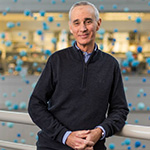March 2016

Alan Schwartz, MD
Alan Schwartz, MD, serves as medical director of the Johns Hopkins Sleep Center on the Bayview campus in Baltimore, Maryland. Defining himself as part clinician, part researcher, and part professor, Dr. Schwartz says his primary academic focus has been to diagnose and treat sleep-disordered breathing, with a special emphasis on mechanisms of upper-airway obstruction during sleep.
One of his major initiatives has been to establish a sleep research laboratory at Hopkins. Launched in 1999, the Center for Interdisciplinary Sleep Research and Education draws investigators from around the world to conduct research and clinical trials. Dr. Schwartz and his colleagues have also spent the last decade developing novel mouse models of obstructive sleep apnea.
Recently, Dr. Schwartz has had the satisfaction of seeing a new treatment result from laboratory work his team has been doing over the past 25 years. “It is a medical device for treating obstructive sleep apnea. Similar to a pacemaker, it is implanted below the collarbone with a lead tunneled to the hypoglossal nerve,” he explains, “When a patient turns it on at night, the device stimulates the nerve, which then activates the muscles of the tongue, moving it forward so the airway opens up during sleep.”
Vsevolod “Seva” Y. Polotsky, MD, PhD, professor of medicine in the Division of Pulmonary and Critical Care Medicine at Hopkins, describes Dr. Schwartz as a “colleague, mentor, and friend for many years.”
“He taught me a wide range of things, from pulmonary and upper-airway physiology, grant and manuscript writing, and the art of engaging colleagues into productive collaboration and mentoring trainees and lab staff members,” she says. “Alan has been a sounding board for most of my successes and failures and a perpetual source of indispensable advice. I credit Alan with directing my scientific career track.”
Dr. Schwartz first became interested in sleep medicine in the mid-1980s. After attending medical school at Johns Hopkins, he completed his residency at Mt. Sinai Medical Center in New York and then returned to Hopkins for training in pulmonary and sleep medicine.
“At that time, sleep medicine was in its infancy. Two of my mentors—Flip Smith and Ave Gold—were my prime movers into this arena. I found the field exciting and the interaction between respiratory and brain mechanisms intriguing.”
Dr. Philip “Flip” Smith, who is still on the Hopkins faculty, shares this insight into Dr. Schwartz’s personality: “Alan’s only problem is he can’t say no. “He has an open-door policy, and there is always someone in the room—a fellow, a faculty member, or some errant graduate come back to say hello.”
What does Dr. Schwartz find most rewarding about medicine?
“I like listening to patients tell their stories—how they put them together, how they describe what they are experiencing,” he says. “Sleep can go awry for many reasons, like stress. So part of getting the history from every patient includes a time when I stop asking questions and just listen.”
Dr. Schwartz says the ATS has been very important to him over the years and is his “main touchstone to reality outside of Hopkins.”
“The ATS reflects the focus I’ve made for my career personally—it puts clinical and academic goals all under one roof,” he says. “It supports the research and science, as well as the clinical perspective. As a result, it has attracted like-minded individuals who share the same perspective. Particularly these days, relationships are important since inroads for the field are being made by teams, more than individuals.”
In the next few months, Dr. Schwartz is taking the next steps with Sueño Perú (“Peru Sleep”), a project designed to assess sleep-disordered breathing in underserved communities abroad. His team has surveyed sleep-disordered breathing patterns in a large Peruvian cohort, and he looks forward to launching a public health strategy for mitigating sleep-disordered breathing in Peruvian highlanders. He has a strong personal attachment to the country. He and his wife, Carla, spent time there together as medical students, and they have kept in close contact with Peruvian friends and colleagues.
Dr. Schwartz and Carla live in the heart of Baltimore and enjoy cultural opportunities there, including the symphony and local theater. They have two grown children: a son, who is finishing medical school at the University of Chicago, and a daughter, whose work involves promoting sustainable living and energy-efficiency programs in Baltimore. In his free time, Dr. Schwartz likes to cycle, sail, and jog.

